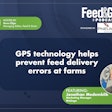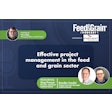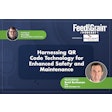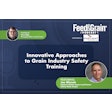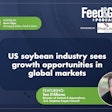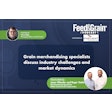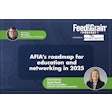Steven Kilger, managing editor for Feed & Grain, and Christy Swoboda, technical services director for Romer Labs, talk about the 2021 harvest's mycotoxin activity. They also discuss proper mycotoxin mixing & sampling, when to send samples to a lab, why mycotoxins are being detected more now than ever before, and how mycotoxin testing has advanced.
Transcription of Christy Swoboda, technical services director for Romer Labs
Steven Kilger: Hi everyone, my name is Steven Kilger. I'm the managing editor of Feed & Grain. And today, I'm talking with Christy Swoboda, technical service director for Romer Labs. At the end of December last year, Romer Labs and Feed & Grain put on a webinar about mycotoxin trends in 2021. Now Christy's joining us to give us an update on all things, mycotoxins and what's changed since that webinar. Hi, Christy.
Christy Swoboda: Hello.
Kilger: So can we look back at the 2021 harvest, which is complete now? Can you kind of tell me what you observed?
Swoboda: Sure. So when we look back at the 2021 harvest, I will say, for the most part, the levels of mycotoxin contamination that we observed analytically fell along those more historical lines, you know, so we see low levels of aflatoxin, fumonisin, Don specifically, and then we see those typical regionalized pockets, where we might find some higher contamination levels that are kind of experienced year over year. This year, along with the last couple, we've added an additional focus on Ochratoxin A and even T-2 and HT-2 into our analytical testing. Those are really driven by what some industry partners say. The infant soy-based market is an additional focus for ochratoxin. Even though the poultry industry or the pet food industry wants to drive down some analytical detection limits for T-2 and HT-2, but really, if we just look at the crop harvest in general, I'd say nothing new and noteworthy per se. When we talk about kind of regionalized occurrences of mycotoxins, you didn't think about where in the country we experience more extreme weather patterns. So those extreme patterns are kind of where we find those pockets of maybe, hey, we have more aflatoxin here. Oh, we have more Don there.
Kilger: So to what kind of extent do those events really impact mycotoxin levels? I'm thinking of storms and floods and all that kind of a but even extreme heat and things like that. Right?
Swoboda: Right. So yeah, the weather is actually the largest contributor to mycotoxins across the country. So really any weather event like you just mentioned, you know, drought stress, heavy rainfall, maybe you know, hurricanes come through, could have tornadoes, you know, or just high winds, hail that falls, really any of those weather events that occur on the plant can lead to that plant being under stress. And really, whenever there's stress on the plant, it kind of creates those additional avenues for mycotoxin development to occur. You know, if we just talk about drought, drought stress, and if we just talk about the corn crop, you know, it's often brought to mind immediately, oh, let's watch for aflatoxin and let's watch for fumonisin. So if you think kind of year over year, fumonisin is is known to occur at some level in the corn crop coming out of the south. Well, you think about July and August summers in the southern US; they're hot and dry. So the weather, you know, is definitely the largest contributor to mycotoxin development.
Kilger: Were there any specific weather events or trends that you'd like to discuss anything that stood out to you?
Swoboda: Right, nothing in particular from 2021? You know, we did have I believe it was Hurricane Ida came through, you know, made some of the peanut industry a little nervous for a little while. Luckily, nothing regarding mycotoxins kind of came to fruition there, you know, but with each of those industries, and each of the different regions, you know, we just year over a year know what to watch for nowhere to kind of put our additional focuses and kind of hope for the best.
Kilger: During our webinar. We had it towards the end of 2021. We had several questions about various mycotoxin testing and stuff. One of them was about sampling, can you kind of give your recommendations on what a good sample is and how to take a good sample?
Swoboda: Sure. So when we talk about mycotoxin sampling and sample, the sample variability is a topic that we still discuss today, as we could see by the questions coming in, but also is something you know, we've discussed over the decades. Part of the reason that it continues to remain a focus is that mycotoxins are distributed in a non-homogenous fashion, either within the field or within a lot of grain.
If you think about a field of corn, or if you think about a rail car, think about a truck. The mycotoxins are going to impact some of the corn kernels potentially, or you know, different commodities, but they're not going to impact every one of them. So we have to take extra care and be very diligent, that when we pull samples, we really pull representative samples to make sure one on an analytical basis that we don't miss the mycotoxins, in which case, we would then under-report a true contamination value. Or, you know, on the flip side, we could hit what's called a hot spot. And we could find all of the mycotoxins in the sample that we pulled.
At that point, we've deemed a load or a lot contaminated when maybe it really isn't as bad as that data point says it is. So you know, time and time again, I go back to an old study, but it was well designed, and it's from the USDA goes back to a couple of gentlemen Whitaker and Dickin that did it. You know, there's many new reports, studies, publications, journals, you know, USDA handbook, all of those things that that talk about sampling guides, that through the old USDA study that I talked about, you know, they determined analytically, that only 2% of the air in the analysis is related to the end method that a consumer detects, or selects that 98% of any error that you get in mycotoxin analysis is associated with the sampling, you know, and if we think about it, just to walk through it, if we assume a lot is like 50,000 kgs, you know, we need to take that 50,000 kg sample, and come up with a two-kilogram sample to submit for testing.
How well do we pull from little spots out of 50,000 kg to get our two, and then once we get our two kilograms, we're going to put it through a mill, we're going to grind it, we're going to homogenize it. And then we're ultimately going to take 10 to 50 grams from that, for our analytical method, you know, so we're starting with something around 50,000 kg, and we're ending up with maybe 10 grams for testing.
You can just kind of assume and then the scale down of that, you know, analytically where things can go wrong in that sample, you know, even the USDA handbook, or USDA guidebook on mycotoxin sampling, they reference pulling like 1,000 gram on the low end to maybe a 10-pound sample on the high end. And again, you're taking 1000 grams to 10 pounds, and you're trying to make 10 grams out of it. So So sampling is, to be one of the most critical things that we have to be attentive to really understand the true and the accurate mycotoxin contamination level in anything.
Kilger: Excellent. Yeah, I've noticed over the years that even one I think is sampling, I think a truck probes and how it's gone from put do one probe and then grind it and call it good to now they do multiple probes. Do you have any kind of suggestions on that?
Swoboda: No. And that that's very accurate years and decades gone by was the statement, "Oh, just collect a coffee can," "give me a coffee can sample" you kind of envision somebody just scooping a coffee can off the top or out of the bottom of the truck. And, and then we've learned over the years that oh, we missed this or Oh, we hit that. And that's not right. So yeah, definitely taking a multi-probe approach is best. We're trying to collect two kilograms, let's maybe pull a half a kilogram from four spots or quarter kilogram from eight spots, and let's get the top of the truck, the middle of the truck, the bottom of the truck, same with a rail car, or that sort of thing. And if we're pulling a sample from moving either an auger system or our production line, the same thing not to take it just a single point in time, but to try and collect a sub-sample over the full time that that that unit is running to try and get that Representative result there.
Kilger: Yeah, excellent. So once the sample is kind of taken, can you kind of speak to the particle size requirements best protocols that
Swoboda: yes, because in mycotoxins, particle size does matter, which is a bit different from some of the other industries that even roamer operates in. But when we talk about particle size, what we recommend to customers who are either using a test kit at their facility or that are sending samples in, say to a contract lab is you want to get that sample, say of corn down to a corn flour consistency. We don't want corn grits. We don't want crack corn. We don't want to see any chunks of that corn remaining. So get it all the way down to corn flour. The USDA handbook even recommends that you want 60% To pass through a 20 mesh sieve. So they're really pushing the cornflour break down as well. And that pushing the particle size small just increases our opportunity to get that sample homogenous. Because if it's better to ground, we can mix it better. And then we get the better analytical result that we're looking for.
Kilger: Yeah, yeah, that makes sense to me. After The webinar, there were several questions that you answered already method detection limits. Now, I am a layman and a journalist. And I have no idea what that is. So can you talk a little bit more about that?
Swoboda: Sure. So I've actually spent a decent amount of time just this week on this topic, customers. But when we talk about detection limits, and we talk about analytical methods, a test kit or a reference method, we talk about the lowest limit of mycotoxins that we can find. What's the amount that we can find? And what's the amount that we can then quantitate out of that? I'll reference back to that USDA guidebook again. I think they do a good job. And then, we look at their test kits certification program. And they talk about, say, aflatoxin at five ppb, they want to know, they want to make sure that every test kit, every analytical method, at least can detect five ppb of airflow. If you can, great if you can't find a way to improve your method, we talked about looking for Dawn around a point five PPM fumonisin, the same ochratoxin Down to five ppb. So they're fairly low, low levels of contamination that we're looking for aflatoxins and okra toxins and even psoralen own we focus in the parts per billion we're done and few Monessen we believe animals have a little more not resistance to but a tolerance a little more tolerance to um, so we're often looking at parts per million of those, but industry both in the manufacturing industries, as well as in the academic industry continue to push request for limits of detection lower, not saying we're chasing that analytical zero, you know because we'll never get there. There will always be some level that we can detect. But you know, like, like aflatoxin, for example. You know, a few Mollison talks about five parts per billion. Analytically, we have methods where we can look down to one part per billion. Can we see point five? Can we see point one? Just the more we understand the impact from a toxicity standpoint or from a synergistic toxicity standpoint of what mycotoxins do to humans and animals kind of the lower we continue to push these detection limits of interest. So along with that, of course, the lower we push the detection limits means the increased probability that we're finding mycotoxins, but we're finding it at very low levels. So then you have to weigh into that conversation. What does that analytical data mean? And what do with it now that I can detect something at these lower levels?
Kilger: Yeah, so even though we're, there are more hits, right, it's just percentages, we weren't able to really detect earlier. Correct?
Swoboda: Correct, very valid. Excellent. So is there a difference between, say, rapid test kit you would get from a company like Romer and reference methods?
Swoboda: Right, in mycotoxins, the majority of the rapid test kits that are on the market are based upon reference methods. So if we look at a lateral flow device for mycotoxins, the data that was generated as part of the validation package for that test kit included testing by HPLC or by LC ms. So there is a very good correlation within the mycotoxin. Industry, when it comes to, especially in grains. If I run a corn sample, can I get a similar result on my water-based lateral flow device at the probe station? And can I get a very similar result coming out of a contract lab for an LC? Ms. Ms result? Man? The answer is yes. When it comes to those raw grains, test kits are very good. They're very well suited. They have strong applicability in the marketplace. So there you see very similar results. Now, where I'll caution customers is the more complex the matrix is, or especially the more complex a feed or food product is, the less likely it is that you're going to find that good linearity. So test kits struggle with complex samples. So when we think maybe corn byproducts, we think pelleted animal feed, if we think feeling feeding silage is or TMRS, or mixed rations or things like that. They're a very complex sample. They're gonna have a lot of pigments, a lot of colorations, they could have oil content and things like that in there. So I would just caution the further away from a simple grain we get, the higher the probability is that to really get an accurate result, we need to be using a reference method to do that.
Kilger: That makes sense. I mean, that's why you probe your grain at the start, right?
Swoboda: Right to Know, know the levels going into your brain product for sure. Yeah,
Kilger: yeah. So a lot of chatter about risk assessment happened in the webinar. Can you provide some thoughts regarding industry-performed risk assessments?
Swoboda: Correct. It has been something that's been chatted about for a while. I think it's it's graining, not great gaining traction more as we focus on branding. Or as we focus on compliance regulations, things like that. There's no one size fits all answer when it comes to a risk assessment. So if companies approach us, where should we be testing how many samples we should be pulling? What do you think about this? What do you think about that? We can't give them those answers. We can give them our thoughts on okay, we've seen aflatoxin in corn from the Upper Midwest, or oh, we see few Monessen and corn from the southern US or you know, things like that. But knowing your region that you operate in, or at least the region where you're pulling your grain from. And then in that region, understanding what levels are seen and what levels are out there is really kind of step one to the risk assessment. So if you've not been testing, or if you test the if you test on more of a surveillance manner, you know, my first recommendation would be to increase testing, maybe do a vendor survey or a crop survey or an incoming grain survey or, or just something to really understand what are we taking in? What do we have going on? And from there, then you can start to work through how many samples we should be pulling, deciding for yourself at what point and what focus you put on testing grains coming in, testing products in progress, and then testing finished products as well. From my point of view, I think you have to be testing for mycotoxins at all points. You know, I don't think testing just on the front end is enough because something can get through the same if you're light on testing on the front end and more heavy on the back end. You're taking a producer's wrist in that regard. So it's really the quality team and the management team sitting down and working through how much risk they're willing to take, at what levels to feel comfortable, that they really have mycotoxins under control. At what point can you kind of draw that the last line in the sand that says, as long as we're doing this, we're doing everything in our power to keep it under control?
Kilger: Especially with traceability being such a big issue right now? I mean, they're gonna track that back to you one way or another.
Swoboda: Yeah, yeah. And then those risk assessments, you know, though, they'll have to look different depending upon the mycotoxin you're interested in. I'm going to look at aflatoxin in corn differently than I'm going to look at fumonisin and rice, for example, because fumonisin and rice are not very common. But aflatoxin and corn are very common. Plus along with the recipes, you know, that we're producing how much of what grain is going into our product and, and so you really have to get into those details and, and that minutiae of activities, to really get a good handle on what you need to do.
Kilger: It sounds more intimidating than it is, I'm sure because over the last even my eight years or so in the industry now, I mean, your rapid tests and things have really advanced and are easier to use than ever and better quality than ever and so, yeah, really set something up.
Swoboda: Yep. And I agree with that, because, you know, I've, I've been working in mycotoxins for little over 19 years, myself and I started in an analytical lab. Twenty years ago, we were doing corn testing in a lab by HPLC because that was kind of the gold standard. And that's what everybody did. And then over the years, as test kits really became more available, you know, USDA certification programs or AOA, see approval programs got gained better traction than we started seeing customers take that corn testing to their facilities. And then we start testing more the feed products or the complete corn byproducts are things that test kits can handle. And you know, ten years ago, test kits were even solvent-based. We were selling to the customers, but they needed to use a Sita nitro water or a methanol-water, a hazardous solvent that they then had to dispose of when those test kits. Well, you know, the last few years, test kits have now transitioned to water-based extraction, you know, so it's safer than for their employees safer on the environment, all those things. So I agree as we continue to push the boundaries on analytical capabilities and ease of use for the customers, the industry and where we test and how we monitor continue to evolve.
Kilger: Excellent. I'm sure you guys will continue to evolve as the years go on to the more you'll have the mixed products down.
Kilger: So those are the questions I have. Do you have any closing thoughts?
Swoboda: I guess the main thing is that you know, there will always be mycotoxins. You know, there, we stated they're driven by weather patterns. Currently, there's nothing that can be done. Once there's contamination in grain to remove, it can't process it out of there. We can't get it out of there. You know, so if it's there, the industry to continue to work to divert its applicable channels to for human food, pet food, you know, animal feed purposes, but so it's always going to be there, and I think regulatory means will continue to tighten. I think we'll push those limits lower or add additional mycotoxin, you know, regulation currently focused on aflatoxin. There's guidance on Don and fumonisin. But no, I mentioned we do a lot of psoralen on testing, but psoralenown is currently not a regulated toxic thing we teach you in HD too. So I think there are things there that'll continue to drive the industry. Then in some of that's just as the research furthers, the understanding furthers, develops on truly herd health aspects and the impact of these toxins even at very low levels, on animals, or in levels, you know, synergistic effects. I think as we understand more there, it helps to guide the industry, and then we can throw in the topics of emerging mycotoxins as well. Mycotoxins have been known for hundreds of years can go back to some of the early plague events in hypothesize that mycotoxins played a role. So, but even with that, you know, we're still discovering new mycotoxins or understanding the impact of new mycotoxins. You don't want to hurt health as well.
Kilger: It's great to know. I didn't know about the plague's possible origins. Yeah. Yeah. But yeah, I mean, mycotoxins are what byproducts of mold, right? So mold has always been here. It always will be.
Swoboda: That's right. Because, right. That, yep, yep. And in this particular case, yeah, mold and the metabolism of the mold, making them at the mycotoxins definitely problematic. But as you said, molds have always been our round and some molds such as penicillins, you know, proven to be a very good thing for
Kilger: us. And plus, I mean, testing for all that stuff. I mean, it's nice to be ahead of the regulatory process sometimes. Yes, I agree. I agree. It adds a nice value add to your product as well. Yes. Yes. Well, thank you so much for talking to me today. I really appreciate you stopping by and having a chat about mycotoxins and what they're, what they're doing out there. Thanks to everyone who is listening. We hope you enjoyed this podcast, and make sure you check out that webinar if you haven't yet. And stay tuned for any content. Alright, bye, Christy.
Swoboda: All right. Thank you, Steven.


